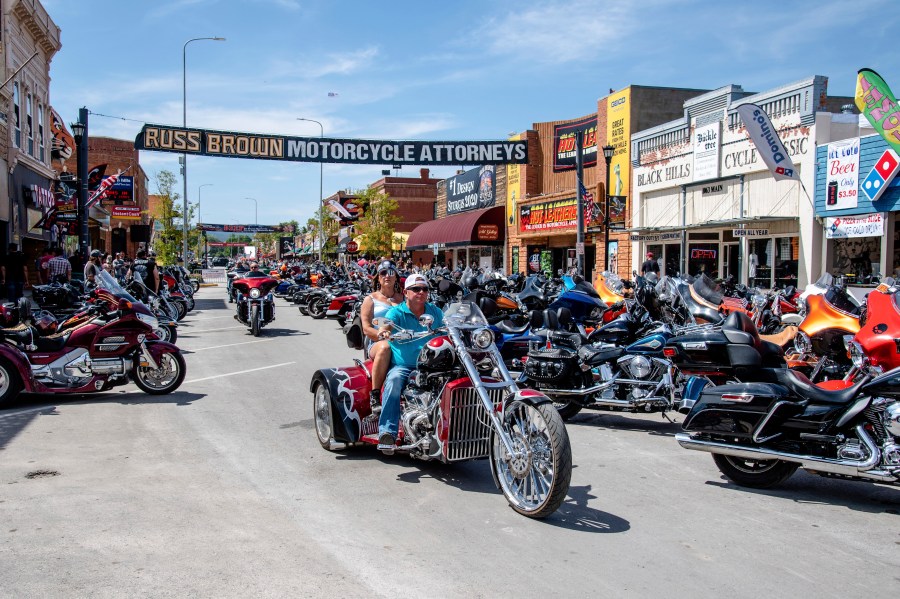SIOUX FALLS, S.D. (AP) — Rumbles from the motorcycles and rock shows of the Sturgis Motorcycle Rally have hardly cleared from the Black Hills of South Dakota, and the reports of COVID-19 infections among rallygoers are already streaming in — 178 cases across five states, according to contact tracers.
In the three weeks since the rally kicked off, coronavirus cases in South Dakota have shot up at a startling pace — sixfold from the early days of August. While it is not clear how much rallygoers spread the virus through secondary infections, state health officials have so far reported 63 cases among South Dakota residents who attended the event.
The epicenter of the rally, Meade County, has become red-hot with new cases, reaching a per capita rate that is similar to the hardest-hit Southern states. The county reported the highest rate of cases in the state over the last two weeks, according to Johns Hopkins researchers.
The Black Hills region’s largest hospital system, Monument Health, warned Friday that it has seen hospitalizations from the virus rise from five to 78 this month. The hospital was bracing for more COVID-19 patients by converting rooms to intensive care units and reassigning staff.
Virus cases were already on the rise when the rally started, and it’s difficult to measure just how much the Sturgis Motorcycle Rally is to blame in a region where local fairs, youth sports leagues and other gatherings have resumed.
However, Meade County could be a harbinger of things to come for the Upper Midwest as infections ripple from those events, said Dr. Michael Osterholm, director of the University of Minnesota’s Center for Infectious Disease Research and Policy.
“This coronavirus forest fire will keep burning any human wood it can find,” he said. “It will find you, and it’s so infectious.”
Health officials in North Dakota, Wyoming, Minnesota and Wisconsin all reported cases among people who attended the rally, with North Dakota also reporting two hospitalizations. Some health officials noted people could have caught the virus elsewhere.
A team from the Centers for Disease Control and Prevention determined last year’s rally looked like a “superspreader event.” The team said the event offered a lesson: Such large gatherings can result in “widespread transmission” of infections and attendees should follow precautions like getting vaccinated, wearing masks and social distancing.
The aftermath of this year’s rally looks eerily similar to last year — when the event heralded a wave that did not subside until the winter.
But the pandemic fallout from the rally won’t be seen for weeks and an exact case count will likely remain unknown, Osterholm said.
Daniel Bucheli, a spokesman for the state Department of Health, said the virus spike is following “a national trend being experienced in every state, not just South Dakota.”
He also pointed out that Meade County’s vaccination rate of 45% lags behind the statewide rate of 56% eligible people vaccinated.
The city of Sturgis also downplayed the virus numbers, issuing a statement that blamed the increase in positivity rate on a “significant increase in testing performed to proactively reduce the spread of COVID-19″ and accusing “individuals in the national media” of mischaracterizing the event.

Despite the more contagious delta variant, this year’s motorcycle rally was even bigger than last year. More than 500,000 people showed up during the 10-day rally.
The streets of Sturgis filled with rallygoers drawn to the libertarian rules of South Dakota — motorcycle helmets weren’t required, minimal attire and bodypainting were welcome, and masks were often nowhere in sight. Bikers bellied up to bars and packed into rock shows.
Two bands that performed at the rally have canceled shows after musicians came down with the virus. Corey Taylor, the lead singer of Slipknot who had embarked on a solo tour, told fans he was “very, very sick” from COVID-19, though he did not say where he contracted it.
“This is the worst I’ve ever been sick in my life,” Taylor said in a Facebook video this week. “Had I not been vaccinated, I shudder to think how bad it would have been.”






